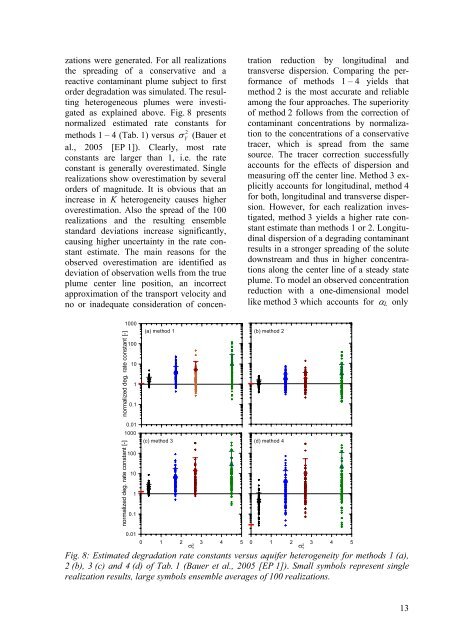Applied numerical modeling of saturated / unsaturated flow and ...
Applied numerical modeling of saturated / unsaturated flow and ...
Applied numerical modeling of saturated / unsaturated flow and ...
You also want an ePaper? Increase the reach of your titles
YUMPU automatically turns print PDFs into web optimized ePapers that Google loves.
zations were generated. For all realizations<br />
the spreading <strong>of</strong> a conservative <strong>and</strong> a<br />
reactive contaminant plume subject to first<br />
order degradation was simulated. The resulting<br />
heterogeneous plumes were investigated<br />
as explained above. Fig. 8 presents<br />
normalized estimated rate constants for<br />
2<br />
methods 1 – 4 (Tab. 1) versus � Y (Bauer et<br />
al., 2005 [EP 1]). Clearly, most rate<br />
constants are larger than 1, i.e. the rate<br />
constant is generally overestimated. Single<br />
realizations show overestimation by several<br />
orders <strong>of</strong> magnitude. It is obvious that an<br />
increase in K heterogeneity causes higher<br />
overestimation. Also the spread <strong>of</strong> the 100<br />
realizations <strong>and</strong> the resulting ensemble<br />
st<strong>and</strong>ard deviations increase significantly,<br />
causing higher uncertainty in the rate constant<br />
estimate. The main reasons for the<br />
observed overestimation are identified as<br />
deviation <strong>of</strong> observation wells from the true<br />
plume center line position, an incorrect<br />
approximation <strong>of</strong> the transport velocity <strong>and</strong><br />
no or inadequate consideration <strong>of</strong> concen-<br />
normalized deg. rate constant [-]<br />
normalized deg. rate constant [-]<br />
1000<br />
100<br />
10<br />
1<br />
0.1<br />
0.01<br />
1000<br />
100<br />
10<br />
1<br />
0.1<br />
0.01<br />
(a) method 1 (b) method 2<br />
(c) method 3 (d) method 4<br />
0 1 2 3 4 5<br />
tration reduction by longitudinal <strong>and</strong><br />
transverse dispersion. Comparing the performance<br />
<strong>of</strong> methods 1 – 4 yields that<br />
method 2 is the most accurate <strong>and</strong> reliable<br />
among the four approaches. The superiority<br />
<strong>of</strong> method 2 follows from the correction <strong>of</strong><br />
contaminant concentrations by normalization<br />
to the concentrations <strong>of</strong> a conservative<br />
tracer, which is spread from the same<br />
source. The tracer correction successfully<br />
accounts for the effects <strong>of</strong> dispersion <strong>and</strong><br />
measuring <strong>of</strong>f the center line. Method 3 explicitly<br />
accounts for longitudinal, method 4<br />
for both, longitudinal <strong>and</strong> transverse dispersion.<br />
However, for each realization investigated,<br />
method 3 yields a higher rate constant<br />
estimate than methods 1 or 2. Longitudinal<br />
dispersion <strong>of</strong> a degrading contaminant<br />
results in a stronger spreading <strong>of</strong> the solute<br />
downstream <strong>and</strong> thus in higher concentrations<br />
along the center line <strong>of</strong> a steady state<br />
plume. To model an observed concentration<br />
reduction with a one-dimensional model<br />
like method 3 which accounts for �L only<br />
0 1 2 3 4 5<br />
�2 �2 Y Y<br />
Fig. 8: Estimated degradation rate constants versus aquifer heterogeneity for methods 1 (a),<br />
2 (b), 3 (c) <strong>and</strong> 4 (d) <strong>of</strong> Tab. 1 (Bauer et al., 2005 [EP 1]). Small symbols represent single<br />
realization results, large symbols ensemble averages <strong>of</strong> 100 realizations.<br />
13

















